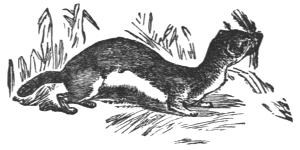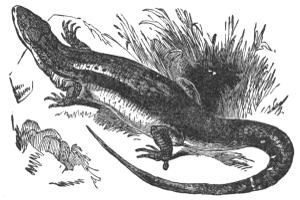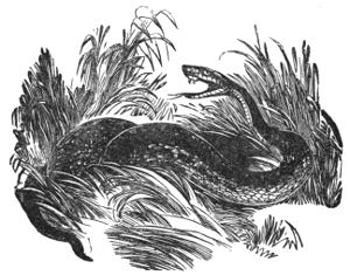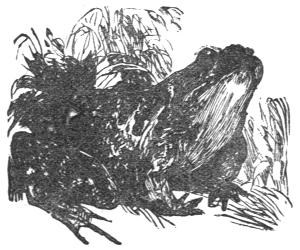 Полная версия
Полная версияThe Common Objects of the Country
I was by no means pleased at the escape of my prisoner; but there was one person more displeased than myself—namely, the gardener: for he, seeing in the far perspective of the future a mole running wild in the garden, disfiguring his lawn and destroying his seed-beds, was extremely exasperated, and could by no blandishments be pacified.
However, his fears and anxieties were all in vain, as is often the case with such matters, and a mole-heap was never seen in the garden. We therefore concluded that the creature must have burrowed under the garden wall, and so have got away.
Sometimes the fur of the mole takes other tints besides that greyish black that is worn by most moles. There are varieties where the fur is of an orange colour; and I have in my own possession a skin of a light cream colour.
A perpetual thirst seems to be on the mole, for it never chooses a locality at any great distance from water; and should the season turn out too dry, and the necessary supply of water be thus diminished or cut off, the mole counteracts the drought by digging wells, until it comes to a depth at which water is found.
I should like to say something of the Hedgehog, the Stoat, and other wild animals; but I must only take one more example of the British Mammalia, the common Weasel.

WEASEL.
Gifted with a lithe and almost snake-like body, a long and yet powerful neck, and with a set of sharp teeth, this little quadruped attacks and destroys animals which are as superior to itself in size as an elephant to a dog.
Small men are generally the most pugnacious, and the same circumstance is noted of small animals. The weasel, although sufficiently discreet when discretion will serve its purpose, is ever ready to lay down that part of valour, and take up the other.
Many instances are known of attacks on man by weasels, and in every case they proved to be dangerous enemies. They can spring to a great distance, they can climb almost anything, and are as active as—weasels; for there is hardly any other animal so active: their audacity is irrepressible, and their bite is fierce and deep. So, when five or six weasels unite in one attack, it may be imagined that their opponent has no trifling combat before him ere he can claim the victory. In such attacks, they invariably direct their efforts to the throat, whether their antagonist be man or beast.
They feed upon various animals, chiefly those of the smaller sort, and especially affect mice; so that they do much service to the farmer. There is no benefit without its drawbacks; and in this case, the benefits which the weasel confers on farmers by mouse-eating is counterbalanced, in some degree, by a practice on the part of the weasel of varying its mouse diet by an occasional chicken, duckling, or young pheasant. Perhaps to the destruction of the latter creature the farmer would have no great objection.
The weasel is a notable hunter, using eyes and nose in the pursuit of its game, which it tracks through every winding, and which it seldom fails to secure. Should it lose the scent, it quarters the ground like a well-trained dog, and occasionally aids itself by sitting upright.
Very impertinent looks has the weasel when it thus sits up, and it has a way of crossing its fore-paws over its nose that is almost insulting. At least I thought so on one occasion, when I was out with a gun, ready to shoot anything—more shame to me! There was a stir at the bottom of a hedge, some thirty yards distant, and catching a glimpse of some reddish animal glancing among the leaves, I straightway fired at it.
Out ran a weasel, and, instead of trying to hide, went into the very middle of a footpath on which I was walking, sat upright, crossed its paws over its nose, and contemplated me steadily. It was a most humiliating affair.
The weasel has been tamed, and, strange to say, was found to be a delightful little animal in every way but one. The single exception was the evil odour which exudes from the weasel tribe in general, and which advances from merely being unpleasant, as in our English weasels, to the quintessence of stenches as exhibited by the Skunk and the Teledu. A single individual of the latter species has been known to infect a whole village, and even to cause fainting in some persons; and the scent of the former is so powerful, that it almost instantaneously tainted the provisions that were in the vicinity, and they were all thrown away.
The Polecat, Ferret, Marten, and Stoat belong to the true weasels; the Otters and Gluttons claiming a near relationship.
CHAPTER III
THE COMMON LIZARD—SUDDEN CURTAILMENT—BLIND-WORM—A CURIOUS DANCE—THE VIPER—CURE FOR ITS BITE—THE COMMON SNAKE—SNAKE-HUNTING—CURIOUS PETS—SNAKE AND FROG—CASTING THE SKIN—EGGS OF THE SNAKE—HYBERNATION—THE FROG—THE TADPOLE—THE EDIBLE FROG—THE TOAD—TOADS IN FRANCE—TOAD’S TEETH—VALUE OF TOADS—MODE OF CATCHING PREY—POISON OF THE TOAD—CHANGE OF ITS SKIN.
I have already said that the birds must be entirely passed over in this little work; and therefore we make a jump down two steps at once, and come upon the Reptiles, of whom are many British examples.
The first reptile of which we shall treat is the common little Lizard that is found in profusion on heaths, or, indeed, on most uncultivated grounds.

THE COMMON LIZARD.
It is an agile and very pretty little creature, darting about among the grass and heather, and twisting about with such quickness that its capture is not always easy. Sunny banks and sunny days are its delight; and any one who wishes to see this elegant little reptile need only visit such a locality, and then he will run little risk of disappointment.
There is one peculiarity about it that is rather startling. If suddenly seized, it snaps off its tail, breaking it as if it were a stick of sealing wax, or a glass rod. Several lizards possess this curious faculty, and of one of them we shall presently treat.
The food of this lizard is composed of insects, which it catches with great agility as they settle on the leaves or the ground. If captured without injury—a feat that cannot always be accomplished, on account of the fragility of its tail—it can be kept in a fern case, and has a very pretty effect there.
One of the chief beauties of this animal is its brilliant eye; and this feature will be found equally beautiful in many of the reptiles, and especially in that generally-hated one, the toad.
In the winter-time the lizard is not seen; for it is lying fast asleep in a snug burrow under the roots of any favourable shrub, and does not show itself until the warm beams of the sun call it from its retreat.
The next British lizard that I shall mention is one that is generally considered as a snake, and a poisonous one; both ideas being equally false. It is popularly known by the name of the Blind-worm, or Slow-worm; and is not a snake at all, but a lizard of the Skink tribe, without any legs.

BLIND-WORM.
The scientific name for it is Anguis fragilis; and it is called fragile on account of its custom of snapping itself in two, when struck.
Only very lately, I saw an example of this strange propensity, and was the cause of it. Near Dover, there is a small wood, where vipers are reported to dwell; and as I was walking in the wood, I caught a glimpse of a snake-like body close by my foot. I struck, or rather stabbed, it with a little stick—for it had a very viperine look about it—and with success rather remarkable, for the very slight blow that the creature could have received from so insignificant a weapon, used in such a manner. The viper was clearly cut into two parts, but how or where could not be seen, owing to the thick leaves and grass that rose nearly knee-high.
On pushing among the leaves, I found with regret that the creature was only a blind-worm.
A curious performance was being exhibited by the severed tail, a portion of the animal about five inches long; this was springing and jumping about with great liveliness and agility, entirely on its own account, for by this time the blind-worm itself had made its escape, and all search was unavailing.
Some ten minutes or so were consumed in looking for the reptile itself; and by that time the activity of the tail was at an end, and it was lying flat on the ground, coiled into a curve of nearly three-fourths of a circle. I gave it a push with the stick, when I was startled by the severed member jumping fairly into the air, and recommencing its dance with as much vigour as before. This performance lasted for some minutes, and was again exhibited when the tail was roused by another touch from the stick. Nearly half-an-hour elapsed before the touch of the stick failed to make the tail jump, and even then it produced sharp convulsive movements.
The object of this strange compound of insensibility and irritability may perhaps be, that when an assailant’s attention is occupied by looking at the tail, the creature itself may quietly make its escape.
The food of the blind-worm is generally of an insect nature, and it seems to be fond of small slugs. The country people declare that it is guilty of various crimes, such as biting cattle and similar offences, of which bite an old author says that, “unless remedy be had, there followeth mortality or death, for the poyson thereof is very strong”.
Fortunately for us, we have but one poisonous reptile, the viper; and the slow-worm is as innocent of poison as an earthworm. It is true that, if provoked, it will sometimes bite; but its mouth is so small, and its teeth so minute, that it cannot even draw blood.
The names that are given to it are hardly in accordance with its formation, for it is not very sluggish in its movements, although it can be easier taken than the lizard; while it is anything but blind, and its eyes, though small, are brilliant. Perhaps the epithets ought to have been applied to the givers, and not to the receiver.
As for the real snakes, there are but two species in England, one being called the Viper, or Adder, and the other the Ringed, or Grass-snake. The Viper is rather to be avoided, as it is possessed of poison-fangs, and if irritated, is not slow in using them.
Of this latter I have little to say, and would not have mentioned it excepting for two reasons: the one to enable any person to distinguish it from the common snake, and to avoid, as far as possible, the chance of being bitten; and the other to tell how to heal the bite, should so untoward an event happen.
Poisonous snakes may be readily known by the shape of their head and neck; the head being very wide at the back, and the neck comparatively small. Some persons compare the head of a poisonous snake to the ace of spades, which comparison, although rather exaggerated, gives a good idea of the poison-bearing head. It has a cruel and wicked look about it also, and one recoils almost instinctively.

VIPER.
Should a person be bitten by the viper, the effects of the poison may be much diminished by the liberal use of olive oil; and the effect of the oil is said to be much increased by heat. Strong ammonia, or hartshorn, as it is popularly called, is also useful, as is the case with the stings of bees and wasps, and for the same reason. The evil consequences of the viper’s bite vary much in different persons, and at different times, according to the temperament of the individual or his state of health.
I may as well put in one word of favour for the viper before it is dismissed. It is not a malignant creature, nor does it seek after victims; but it is as timid as any creature in existence, slipping away at the sound of a footstep, and only using its fangs if trodden on accidentally, or intentionally assaulted.
The second English snake is the common harmless Ringed Snake; which does not bite, because it has no teeth to speak of; and does not poison people, because it has no venom at all.

COMMON SNAKE.
Its only mode of defence is by pouring forth a most unpleasant, pungent odour, which adheres to the hands or clothes so pertinaciously, that many washings are required before it is expelled. Yet it is sparing enough even of this solitary weapon, and may, after a while, be handled without any inconvenience.
To this assertion I can bear personal and somewhat extensive witness; for I have caught and kept numbers of snakes. The worthy villagers must have formed curious ideas of me, and I rather fancy must have accredited me with something of the wizard character; for I contrived to oppose their prejudices—all, by the way, of a cruel character—in so many instances, that they were rather afraid, as well as annoyed. To see them run away, as if from a lighted shell, when I came among them with a snake in each hand, was decidedly amusing, and not less curious was the pertinacity with which they clung to their prejudices.
In vain were arguments used to prove that the snake was not a venomous animal, and ought not to be killed and tortured; in vain did I put my finger into the snake’s mouth, and let its forked tongue glide over my very hand or face; they were not to be so taken in, and they remained wise in their own conceit.
They certainly could not deny that the snake did not bite me, and that its tongue did not pierce me, but the conclusion deduced therefrom was simply that my constitution, or perchance my magical art, was such that I was unbitable and unpoisonable.
No! to them the snake was still poisonous, and its tongue still envenomed.
At one time we had so many snakes that they were kept in the crevices of an old wall, and left to stay or go as they pleased. My boys—I had a school at that time—took wonderfully to snake hunting, and every half-holiday produced a fresh supply of snakes. The boys used to devise the strangest amusements in connection with their snakes, of which they were very proud, each boy exhibiting his particular favourite, and expatiating on its excellences.
One of their fashions, and one which lasted for some time, was to make tunnels in the side of the Wiltshire Downs, and to turn in their snakes at one end, merely for the purpose of seeing them come out at the other.
Then there was a stone-quarry some three miles distant, which was in some parts of the year nearly filled with water. Thither the boys were accustomed to repair for the purpose of indulging their snakes with a bath. They certainly seemed to enjoy the swim, and were the better for it.
Sometimes there was great excitement; for a snake would now and then act in too independent a manner, and instead of swimming straight across, so as to be caught by a boy on the opposite side, would sink to the bottom, and there lie flat and immovable. Long sticks could not be found there; and their only mode of making the snake stir was to startle it by throwing stones. Even then there was a difficulty; for if the stones fell too far from the snake they had no effect, and if they fell on him they might hurt him.
To wait until the truant chose to move would have been hopeless, for snakes are able to take so much pure air into their lungs, and they require so little of it for respiration, that the patience of the boys would be exhausted long before the snake felt a necessity for moving.
Sometimes a snake would try to get away, and insinuate his head and part of his body into a crevice; in that case there was sad anxiety, and judicious management was required to eliminate the reptile without damage. It is a very difficult matter to drag a snake backwards, because the creature sets up the edges of the scales, and each one serves as a point of resistance. So, when the snake is within a crevice, where the scales of the back can act as well as those of the belly, the difficulty is increased.
When such an event took place, the best mode of extracting the snake was to let it glide on, and so lower its scales, and then to pluck it out with a sudden jerk, before it had time to erect them afresh. But as often as otherwise, the snake got the better in the struggle, and by slow degrees was lost to view.
Perhaps the pleasantest portion of snake-keeping was the feeding. It was found that the snakes lost their appetite, and would not eat, though frogs and newts were liberally supplied. So the boys settled the matter by opening the mouth of the snake, and pushing a newt fairly down its throat.
One of the largest snakes that I have seen was engaged in feeding himself, not trusting to boys for any help. I was walking in a field, and heard a strange cry from a neighbouring ditch. On going towards the spot, I saw there a large snake struggling with a frog. The frog was comparatively as large as the snake, and as it had a plain objection to being swallowed, there was some turmoil.
The snake was stretched along the bottom of the ditch, which at this time was dry, and he held in his mouth both hind feet of the frog, who was also stretched forward at full length, resisting with its fore-legs the attempts of the snake to draw it back, and croaking dismally. The strife continued for some time, when I made a sudden movement, and the snake, loosing its hold of the frog, glided up the opposite bank. The frog slowly gathered itself together, sat still for some little time, and then hopped away.
The entire empty skin of the snake may often be found among bushes, where the creature has gone in order to assist itself in casting off its old skin. Snakes, as well as other animals, wear out their coats, and are obliged to change them for others. When the change is about to take place, and a new coat has formed under the old, like a new skin under a blister, the creature betakes itself to some spot where is thick grass, reeds, or similar substances. A rent then opens in the neck, and the snake, by wriggling about among the stems, literally crawls out of its skin, which it leaves behind, turned inside out. Even the covering of the eyes is cast away, and in consequence the snake is partially blind for a day or two previously to the moult, if we may call it so.
Eggs laid by the snake are also of frequent occurrence. I have found them in manure heaps, the warmth of which places is attractive to them. The eggs are white, and covered with a strong membrane, but have no shell. They are laid in long strings, from sixteen to twenty eggs being in each chain.
In the winter the ringed snake retires to a convenient cell, such as a hollow tree, or a heap of wood, and there it remains in a torpid state until the warm weather. Many individuals have been found collected together in these winter quarters, probably for the sake of affording each other mutual warmth.
The reptiles of which we have just treated live exclusively on land, though they may occasionally be found in water; but those which we shall now inspect belong rather to the water than to the land. The most common of these amphibious reptiles, as they are called, is the Frog.
A very curious animal is a frog, and well worth examining, as well in its perfect state as in its intermediate state. To begin at the beginning of a frog’s existence, we find it exhibited in masses of eggs, fixed to each other by a kind of gelatinous substance, and floating in large quantities in ditches or ponds. Each egg is about the size and shape of a pea, and in the centre is the little black speck from which the young frog proceeds.

FROG.
In process of time the egg is hatched, and out comes a queer little creature, with a big head and a flat slender tail, called generally a tadpole, and in some places a pollywog. In this state of life the young creature is simply a fish, with fish-like bones, and breathing through gills, after the manner of fish.
Being very voracious, it grows rapidly: little legs begin to show themselves; and, at the proper season, the gills are laid aside, the tail vanishes, and the little frog is then in its usual form. The circulation of the blood can be well exhibited by means of a microscope, if a tadpole be laid on the stage so as to bring its tail within the focus, care being taken to keep that member well wetted.
At the time when the tail is laid aside, the young frog is very small, and in this state is generally found to swarm immediately after rain. The frog-showers, of which we so often hear, are probably occasioned, not by the actual descent of frogs from the clouds, but from the genial influence of the moisture on the young frogs who have already been hatched and developed, and who have been biding their time before they dared to venture abroad.
Still I would not venture to say that frogs have not descended in the rain, for there are several accredited accounts of fish-showers, both being probably caused in the same way.
For a drawing of the Tadpole, see page 85.
It is not often that frogs are found far from water, for they are the thirstiest of beings, and drink with every pore of their body. If, for example, a wrinkled and emaciated frog is placed in confinement, and plentifully supplied with water, it absorbs the grateful moisture like a sponge, and plumps up in a wonderfully short time.
From the same cause, it parts with its moisture with equal rapidity; and if a dead frog be laid in the open air on a dry day it speedily shrinks up, and becomes hard as horn. The skin and lungs co-operate in respiration, but only when the former is moist. So, in order to secure that object, the frog is furnished with an internal tank, so to speak, which receives the superabundance of the absorbed water, and keeps it pure until it is required for use. So great is the power of absorption that a frog has been known to absorb a quantity of water equal to itself in weight, merely through the pores of the abdominal surface, and this in a very short time.
In England we don’t eat frogs, for what reason I know not. One species of frog is very excellent food, and it is but natural to suppose that another may be so, i.e., if properly cooked. However, the old belief still keeps its ground, that the French are the natural foes of the English, and we ought to hate them, because they “eat frogs and are saddled with wooden shoes”. Still I cannot but think that to eat frogs is better than to starve or to steal, and that to wear wooden shoes is not more humiliating than to wear no shoes at all.
After its fashion, the frog sings, though it is but after a fashion. We call the frog’s song a croak: I wonder what name the frog would give to our singing. When the frog sings, it generally sinks itself under water, with the exception of its head, opens its mouth, lays its lower jaw flat on the water, and sets to work as if it meant to make the best of its time. Even in England we have fine specimens of frog concerts, though not to such an extent as in many other countries. In France the frogs make such a croaking, that we hardly wonder at the rather tyrannous conduct of the noblesse just before the great Revolution. When the nobility or courtiers spent any time in the country, the miserable peasants were forced to flog the water all night, on purpose to keep the frogs quiet, for their croaking was so noisy that the fastidious senses of the fashionables could not be lulled to sleep.
Now-a-days, the people don’t seem to be satisfied with the country croakings, but they import the horrid sounds into the city by means of a toy called a “grenouille,” which, when set in motion, makes a croaking sound just like that of a frog.
As a general fact, frogs are just endurable, and people will inspect them—from a distance—without much ado. But the case is widely altered when they see the frog’s first-cousin, the Toad.
A large volume might easily be filled with tales respecting this much-calumniated creature; in which tales the toad appears to be a very incarnation of malignity, and to be wholly formed of poison. If it burrowed near the root of a tree, every one who ate a leaf of that tree would die; and, if he only handled it, would be struck with sudden cramp. And the cause of this poisonous nature was its liver, which was “very vitious, and causeth the whole body to be of an ill temperament”.



